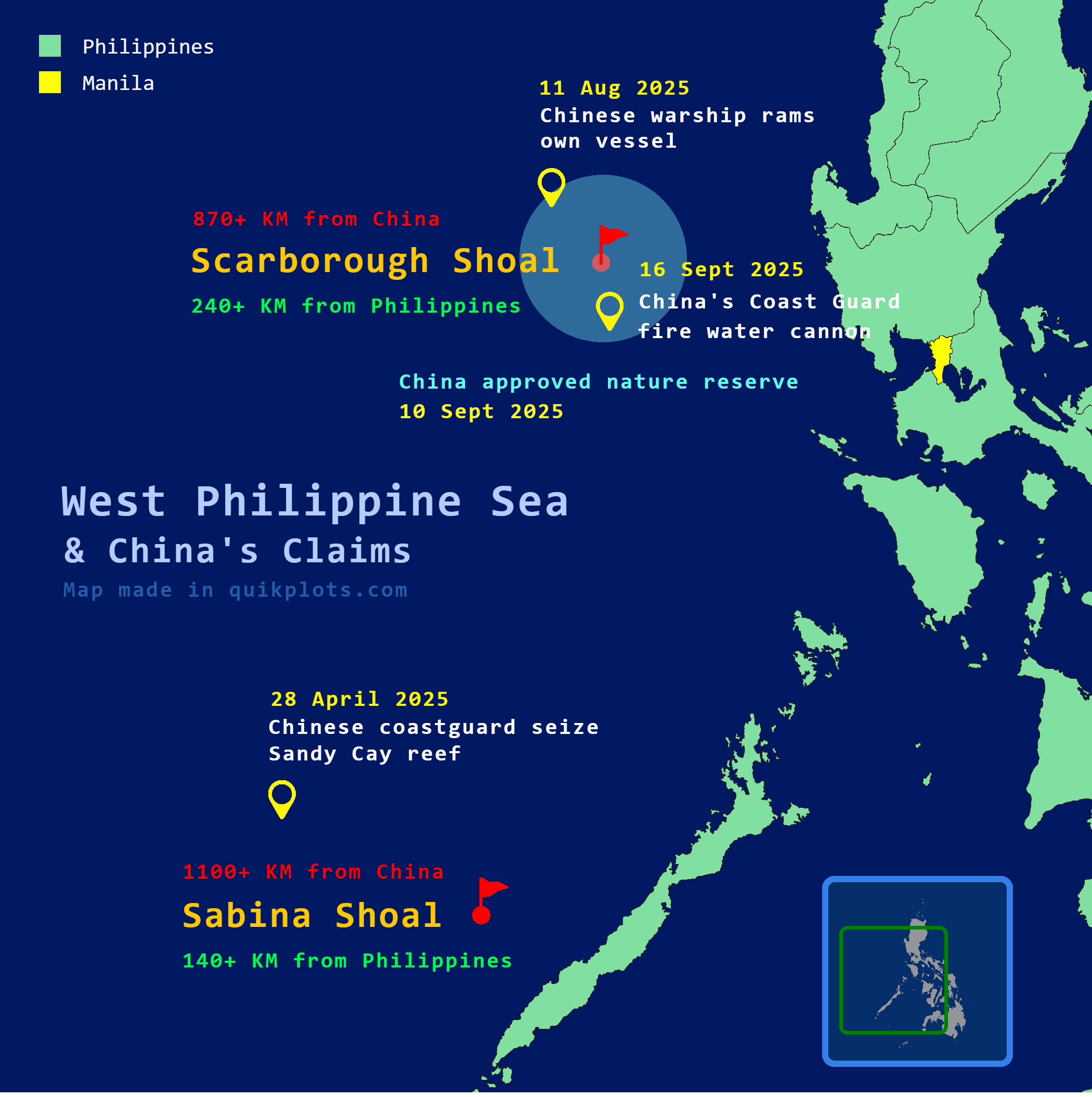West Philippine Sea and China's Claims Map


David Chen
Data Visualization Specialist
David Chen is an expert in transforming complex geographic datasets into compelling visual narratives. He combines his background in computer science ...
Geographic Analysis
What This Map Shows
The visualization titled "West Philippine Sea 🇵🇭 and China's 🇨🇳 claims [Mapped]" provides a detailed representation of the territorial claims in the South China Sea, particularly focusing on the West Philippine Sea. It highlights the contested areas, notably the nine-dash line claimed by China, which overlaps with the maritime zones of several ASEAN countries, including the Philippines. The map also indicates the proximity of significant features like the Scarborough Shoal to the southernmost point of Hainan Island, China.
Understanding this map is critical as it encapsulates the ongoing geopolitical tensions in the region, where maritime rights, fishing grounds, and potential energy resources are at stake. Interestingly, the South China Sea is not only a vital shipping route but also rich in natural resources, making the territorial disputes even more contentious.
Deep Dive into Territorial Claims in the West Philippine Sea
The West Philippine Sea, a segment of the South China Sea, is a focal point of territorial disputes primarily between the Philippines and China. China's claim, represented by the infamous nine-dash line, is a historical assertion that lacks grounding in international law, as clarified by the 2016 ruling from the Permanent Court of Arbitration (PCA). This decision concluded that China's historic rights claims within this line have no lawful effect if they exceed entitlements under the United Nations Convention on the Law of the Sea (UNCLOS).
The implications of this ruling are monumental. The PCA ruled that there was no legal basis for China to claim historic rights to resources within the sea areas falling within the nine-dash line. Despite this, the Chinese government has categorically rejected the ruling, emphasizing their historical narrative over international law. This sets the stage for a complex geopolitical landscape where legal decisions clash with national pride and historical claims.
The Scarborough Shoal, a crucial fishing ground, exemplifies the tension in the West Philippine Sea. Located about 124 nautical miles from Zambales, Philippines, it is a prime fishing area that has seen numerous confrontations between Filipino fishermen and Chinese vessels. Recently, in a bid to reinforce its claim, China declared Scarborough Shoal as a nature reserve on September 10, 2025. This declaration raises significant questions: Is it a genuine environmental initiative, or a strategic maneuver to solidify territorial claims?
The rich biodiversity of the West Philippine Sea, home to vibrant coral reefs and diverse marine life, underscores the ecological importance of these waters. The fishing industry here is vital not only for local communities but also for regional economies. The overlapping claims complicate not just the geopolitical situation but also environmental management and sustainable fishing practices.
Regional Analysis
Looking at the broader context, the territorial disputes in the West Philippine Sea are not isolated incidents. The map indicates that neighboring ASEAN countries, including Vietnam, Malaysia, and Brunei, are also embroiled in their own disputes with China. Each of these nations has its own claims based on historical and legal arguments, further complicating the geopolitical landscape. For instance, Vietnam's claims to the Paracel Islands and parts of the Spratly Islands are grounded in both historical presence and international law, similar to the Philippines.
Interestingly, while China maintains its assertive stance, the responses from ASEAN nations vary. Some have sought bilateral negotiations, while others have turned to international arbitration, as seen in the Philippines’ case. This varied approach illustrates the different levels of power and diplomatic strategies employed by smaller nations in the face of a larger, more powerful neighbor.
Significance and Impact
The territorial claims in the West Philippine Sea carry significant implications for regional stability and international relations. The ongoing disputes affect not only national sovereignty but also the security of vital maritime routes. With the South China Sea being one of the most trafficked shipping lanes in the world, any conflict could disrupt global trade.
Moreover, the environmental impact of these claims cannot be overlooked. Overfishing, illegal fishing activities by foreign fleets, and ecological degradation are pressing issues that arise from these disputes. Sustainable management of marine resources is critical for the livelihoods of millions in the region.
As tensions continue to simmer, the future of the West Philippine Sea remains uncertain. The international community watches closely, as diplomatic efforts, military posturing, and legal battles unfold. Will the pursuit of economic resources lead to further conflicts, or can dialogue pave the way for peaceful resolutions? The answers lie in the complex interplay of national interests, historical narratives, and international law that shape this dynamic region.
Visualization Details
- Published
- September 24, 2025
- Views
- 78
Comments
Loading comments...